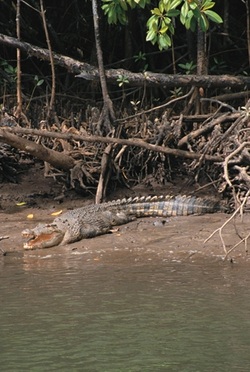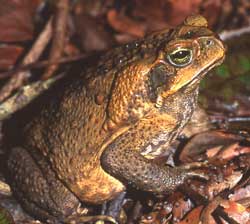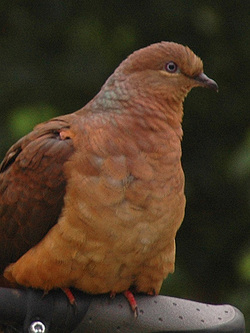
It was of a child lying smiling on the back of a large saltwater crocodile. The scene was the Daly River and the crocodile looked as if it was also smiling and peaceful. It was not. It was dead.
The crocodile had apparently scared the children, which were swimming, when it hauled itself out of the water on to the bank.
That was when it suddenly died.
The local policeman collected it up, intending to present its skeleton to a school for study purposes. When he opened it he found the cause of its death. There was a fresh cane toad in its stomach.
We are generally seeing fewer cane toads than we used to here in our region, but they are still a menace and have been responsible for the loss of much of our valuable wildlife. Following Cyclone Yasi a fresh influx of immature cane toads was noticeable, especially in gardens and other places where there were nooks and crannies in which they could shelter, so despite the apparent drop in population the war against these introduced and highly toxic pests is still important.
Having in the last couple of weeks found a number of large cane toads in the garden I decided to consult the experts. All the cane toad statistics are huge and give much food for thought.

Cane toads can even tolerate levels of salt in the water in which they breed and they eat virtually anything they can swallow, including small mammals, snakes, smaller toads and insects, including honey bees. They only need small puddles to breed.
Their poison, present at all stages of their life cycle from tadpoles to toadlets to adults, can kill a dog by cardiac arrest within 15 minutes.
Cane toads were introduced from Hawaii in 1935 to destroy cane beetles, a task at which they are singularly inefficient and, as most people are aware, they have spread by various means throughout much of Australia, destroying native wild creatures as they go.
A few days ago I found a dead cane toad in one of the water bowls dotted around the garden. Its stomach had been removed, which made me believe it had been taken by a white-tailed or a water rat, both of which are known to flip the toad over before killing it. The stomach is only mildly poisonous.
I was also interested to be told tawny frogmouths and bush stone curlews, crows and, surprisingly wolf spiders, successfully attack these creatures.
This really is a plea to catch and destroy any cane toads readers find to give native creatures such as quolls, antechinus and frogs a better chance to recover their numbers. I believe the best and most humane way to kill them is to wrap them up and pop them in the freezer. Always wear gloves when handling them.
Experiments are continuing to find a method of interrupting their relentless breeding cycle, but in the meantime even creatures as large as estuarine crocodiles are being killed by eating what must appear to be a pleasant snack.

Then, a couple of days ago, there was a large brown bird, unmistakably a pigeon, with a noticeably long tail, sitting in a grapefruit tree in the garden.
Consulting the trusty bird book, we found it was indeed a brown pigeon – that was its name – and it had every reason to be in the garden because it feeds on the fruit of many pest weeds as well as that of pioneer rainforest trees such as the bleeding heart.
It must have approved of our garden, since we are still battling the weeds which have proliferated since Yasi and “beauties” such as nightshade, which it eats, are quite a feature. Clearings in rainforest are also favoured. Yasi certainly made a few holes in our rainforest patch.
And yes, it is a large bird, measuring more than 40cms in length and it is brown, in fact a beautiful, rich brown. I wasn’t close enough to check out what is apparently iridescence on its neck, or fine black barring on the breast, but it was certainly an eye-catcher.
Eventually, it flew heavily away but my guess is that until we have banished the fruiting weeds it will be back.


